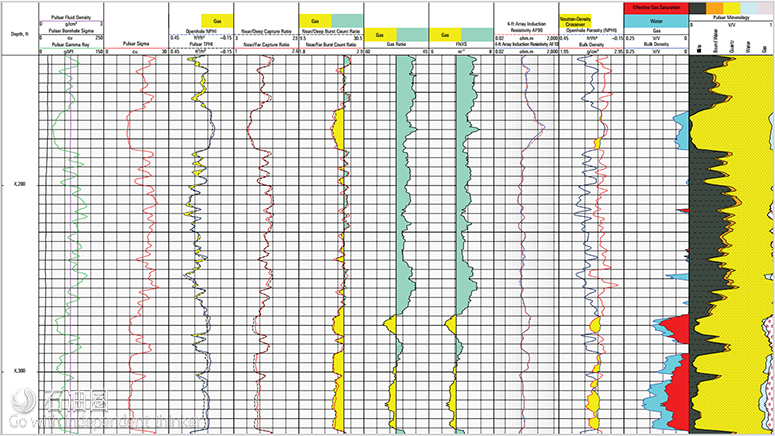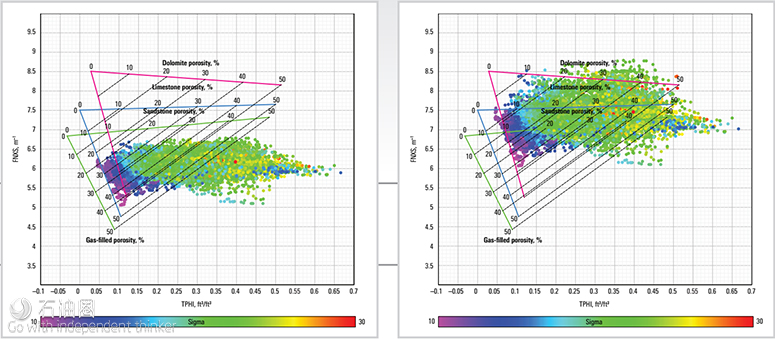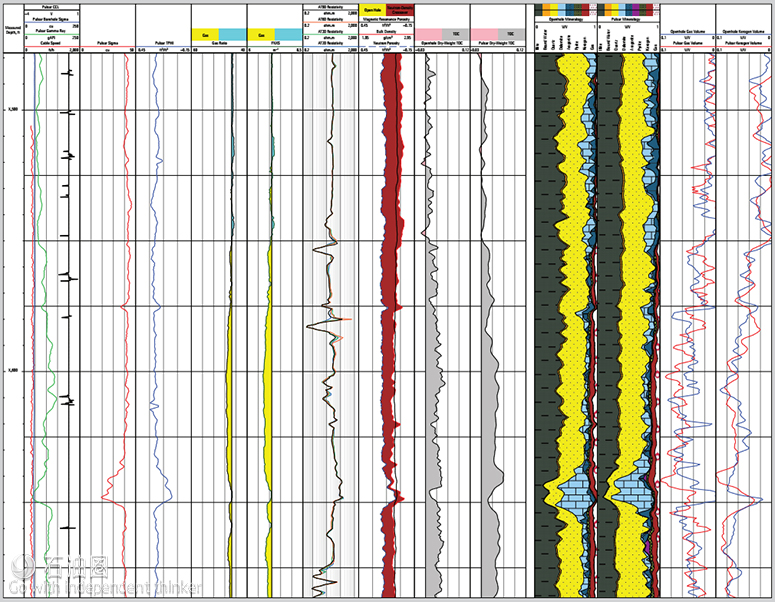Case Study 1
Differentiating Gas and Tight Zones in a Shaly Sand Despite Cement Thickness Greater Than 2 in
Challenge
Telling apart intermixed low-porosity gas-filled zones and tight zones in a shaly sand A US land well was drilled with an 8¾-in bit size but completed with 4½-in 11.6-lbm/ft casing. As a result
of the difference between the hole and casing diameters, the completion has a relatively large cement volume, with
a cement thickness greater than 2 in. The formation lithology is shaly sand, with alternating low-porosity gas-filled zones and very low porosity zones. Although openhole logs had been run, the operator was interested in obtaining an interpretation that would provide greater insight to the formation and its
fluid contents.
Solution
Introducing a new measurement to identify and quantify gas-filled porosity
New Pulsar multifunction spectroscopy service uniquely provides operators with a stand-alone petrophysical volumetric interpretation incorporating robust, high-fidelity quantified mineralogy and lithology for cased holes. No openhole logging data is necessary for complete formation evaluation from
a single run of this one tool. In addition to obtaining highly accurate elemental concentrations—including total organic carbon (TOC)—Pulsar service acquires the traditional cased hole sigma, porosity, and carbon/oxygen ratio measurements but at a higher resolution and significantly faster logging speed.
Pulsar service also provides the new fast neutron cross section (FNXS) measurement that reliably differentiates
gas-filled porosity from liquid-filled zones and tight formations. Because the fast neutron inelastic scattering response used to calculate FNXS is not dominated by particular elements, which is the case for conventional neutron logging, the FNXS measured values for rock matrix and water are in the same range. This makes FNXS insensitive to variation in liquid-filled porosity but highly sensitive to variation in gas-filled porosity.
Results
Differentiating and quantifying gas-filled porosity from tight zones
Logging the shaly sand with a single run of Pulsar service revealed two zones of interest at X,160 to X,180 ft and X,270 to X,330 ft. Both the environmentally corrected FNXS curve and the gas ratio curve it is calculated from (Tracks 7
and 6, respectively) show that only the lower zone contains gas— unlike the very low porosity upper zone that conventional cased hole logging would have assumed was also gas bearing.
The stand-alone volumetric interpretation performed using a linear solver with Pulsar service’s sigma, FNXS, and TPHI
measurements (Tracks 10 and 11) is validated by the previously obtained openhole logs (Tracks 8 and 9).
With this one-run, one-tool solution to logging cased wells, the operator can streamline operations to a single log obtained in the more stable cased wells.
Case Study 2
Replacing an Entire Openhole Logging Program for a Shale Gas Reservoir with One Cased Hole Tool
Challenge
Streamlining resource-intensive openhole characterization
To evaluate a complex shale gas reservoir in Pennsylvania, USA, an operator had run a full suite of openhole logs in the 8¾-in borehole, including triple-combo, nuclear magnetic resonance (NMR), and an advanced spectroscopy tool. The high-definition spectroscopy data was critical in quantifying the complex mineralogy, including the spectroscopy dry-weight TOC as a key input for determining the kerogen volume
for evaluating RQ. Having both density and NMR (Track 7) was necessary to compute the gas volume and total porosity because they have contrasting responses to kerogen and gas.
The operator wanted to learn if the accurate, detailed interpretation provided by an openhole logging program could be achieved with cased hole logging, which would streamline well construction and reduce the risk posed by wellbore instability in the shale reservoir.
Solution
Efficiently conducting formation evaluation in cased hole—without openhole input
Introduced to fill the measurement gaps for cased holes, innovative Pulsar multifunction spectroscopy service obtains a standard formation evaluation suite with a single slim-diameter tool for conducting a complete petrophysical volumetric interpretation. By employing the state-of-the-art cerium-doped lanthanum bromide (LaBr3:Ce) gamma ray detector proven by Litho Scanner high-definition spectroscopy service, Pulsar service similarly obtains highly accurate elemental concentrations for a robust determination of mineralogy, including TOC.
In addition to traditional sigma, porosity, and carbon/oxygen ratio measurements, Pulsar service also provides the new FNXS measurement that reliably differentiates gas-filled porosity from liquid-filled zones and tight formations.
Results
Flagging the transition from gas to low porosity that conventional cased hole logging would overlook Because the well had been comprehensively logged prior to completion with 5½-in 23-lbm/ft casing, there was extensive openhole data from the freshwater-filled well for comparison to Pulsar service’s interpretation. Three separate passes of Pulsar service were made at 300 ft/h in hybrid GSH-lithology mode, which simultaneously acquires data for gas, sigma, and hydrocarbon index (GSH) in addition to elemental spectroscopy including TOC and the carbon/oxygen ratio.
The data were stacked, and a stand-alone volumetric interpretation was conducted using sigma, TPHI, FNXS, and spectroscopy data, all from Pulsar service. At this relatively slow logging speed, Pulsar service’s spectroscopy data, including dry-weight TOC, has very good precision and compares favorably with
the openhole data from the larger-diameter advanced spectroscopy tool.
A stand-alone cased hole interpretation was performed next using all the Pulsar service data in a weighted linear solver with standard end-point values. Again, the interpreted volume compares quite favorably, including the gas volumes and total porosity, even though no openhole logs were used in the interpretation, as would be required if a conventional pulsed neutron logging tool had been run.




 石油圈
石油圈
